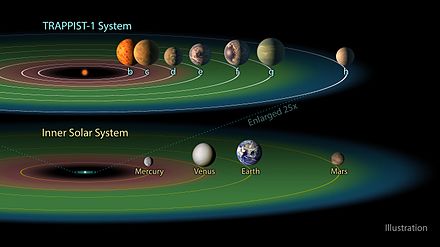TRAPPIST-1 is a planetary system located about 39 light-years away from our solar system, in the constellation Aquarius. It was discovered in 2016 by the TRAPPIST (Transiting Planets and Planetesimals Small Telescope) project, using a telescope in Chile. The system is named after the telescope used to discover it.
TRAPPIST-1 is notable for having seven Earth-sized planets in its habitable zone, where temperatures could allow liquid water to exist on the surface of a planet. This makes TRAPPIST-1 one of the most exciting planetary systems for astrobiology research, as it offers the possibility of finding extraterrestrial life.
The seven planets in the TRAPPIST-1 system are designated b through h, with b being the closest planet to the star and h being the farthest. They all orbit very close to their star, with orbital periods ranging from 1.5 to 19 days. The planets are all believed to be rocky, and their masses range from about 0.4 to 1.4 times that of Earth.
In addition to their sizes and masses, scientists have been able to study the atmospheres of some of the TRAPPIST-1 planets using the Hubble Space Telescope and other observatories. They have found that the planets have a variety of atmospheres, with some likely to have a significant amount of water vapor, and others with little or no atmosphere.
While the TRAPPIST-1 system is relatively close to our own, it is still challenging to study in detail due to its distance and the small size of the star. Nonetheless, ongoing research on this system is expected to reveal more about the nature of these potentially habitable planets and the possibility of finding extraterrestrial life in the universe.

